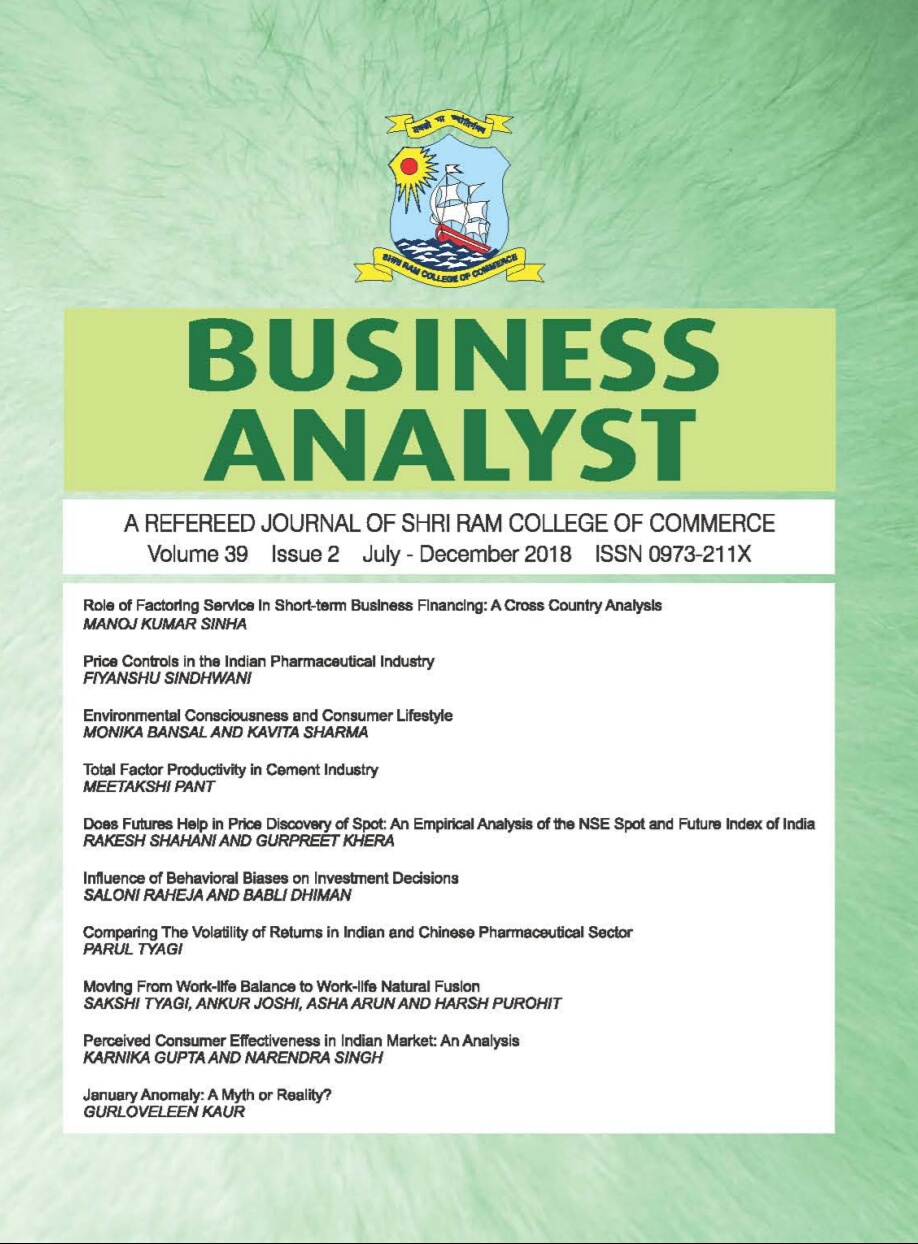ROLE OF FACTORING SERVICE IN SHORT-TERM BUSINESS FINANCING: A CROSS COUNTRY ANALYSIS
Manoj Kumar Sinha
Volume 39, Issue 2 (July 2018 to December 2018)Abstract
Download ArticleIt is focusing on to study trends of factoring service at world, developing countries and developed countries level by using basic as well as stylized research techniques. The paper use growth rate, growth index, year-on-year growth rate, ranking method and dominance technique for analyzing trend of factoring services across the countries. The period of study is 1998-2016. The importance of factoring has been gaining importance not only in developed countries but also in developing countries such BRICS countries during industrialization period. However, there is marginal fall in dominance of developed countries and increase of share of developing countries share in world factoring volume. There should be a more uniform policy environment for factoring services which facilitates and promotes a greater participation by all countries in different countries groupings and within each country grouping.
PRICE CONTROLS IN THE INDIAN PHARMACEUTICAL INDUSTRY
Fiyanshu Sindhwani
Volume 39, Issue 2 (July 2018 to December 2018)Abstract
Download ArticleUsing AIOCD-AWACS database on drugs sold in the Indian pharmaceutical industry, in this paper we have empirically analysed the impact of price control regulation on sales (units and volumes) of price regulated drugs. The latest drug price regulation, DPCO-2013 has an important limitation that it does not cover all the strengths and dosage forms of a regulated molecule. This leaves some part of the molecule price regulated and some part unregulated. We have utilised this feature of DPCO-2013 in our study. Using ‘Difference-in-Difference’ methodology we have compared the trend of sales for the price regulated and price unregulated drugs of the same molecule. We find that there is no difference in difference in total units sold of the regulated and unregulated drugs in the pre vs post intervention period. We do find a significant difference in difference in the sales value of regulated and unregulated drugs. The sales value of regulated drugs has declined over time, that of unregulated drugs has increased over time. Hence, price regulation has neither made price regulated drugs more available, nor has it led to their shortage but the sales revenue of firms has declined over time from the regulated drugs and has increased from the unregulated drugs.
ENVIRONMENTAL CONSCIOUSNESS AND CONSUMER LIFESTYLE
Monika Bansal and Kavita Sharma
Volume 39, Issue 2 (July 2018 to December 2018)Abstract
Download ArticleIdentification and targeting of consumer segments who exhibit some kind of pro-environmental behavior in their use and consumption related activities is an important fac-tor for considering environmental issues in business decisions. An extensive review of extant literature highlights the role of environmental consciousness in explaining pro-environmental behavior, thus, making it imperative to investigate the antecedents determin-ing consumers’ environmental consciousness. The investigation holds particular interest to the marketers as it suggests the market feasibility of eco-friendly product options on the ba-sis of identification of profitable green segments. It is in this backdrop that the study at-tempts to examine environmental consciousness as a construct and identify lifestyle- based antecedents of consumers’ environmental consciousness. The study has its implications for marketing practitioners and researchers who can employ the research findings to draw a clear and distinctive picture of environmentally conscious consumers. Moreover, the find-ings will help marketers to identify green consumer segments in terms of pattern of their life-style.
TOTAL FACTOR PRODUCTIVITY IN CEMENT INDUSTRY
Meetakshi Pant
Volume 39, Issue 2 (July 2018 to December 2018)Abstract
Download ArticleTotal factor productivity (TFP) is a variable which accounts for the effects in total output that is not caused by traditionally measured inputs. TFP is a real variable and also independent in nature. Residual profit increases due to TFP growth. Profit is based on the ordinary economic calculation of cost and revenue but TFP growth is not anticipated so any gain and loss in terms of TFP growth is a return over and above the expected potential profit in the long run. Total factor productivity growth (TFP) is the best-known measure of productivity. TFP is a costless growth. It is disembodied technological progress; therefore, it cannot be attributed to any single factor of production. TFP is also dynamic as it can only be captured over a period of time. The focus of this study is on the Indian cement industry, which is the second largest producer in the world after China. The time period for this study is 26 years, i.e. from 1991 to 2016. It is observed that there is significant productivity growth in more than 60 percent of cement companies. The sign of TFP is negative in almost 77% of the companies under study. It depicts that the malleability of technologies needs to be kept in mind. It is on account of the rigidities in the case of the cement industry that real factor productivity is negative. It also appears that under such circumstances even the costless growth alternative of TFP is not available because TFP is the practice of technology but if the technology is rigid, it is not possible to have positive TFP growth.
DOES FUTURES HELP IN PRICE DISCOVERY OF SPOT: AN EMPIRICAL ANALYSIS OF THE NSE SPOT AND FUTURE INDEX OF INDIA
Rakesh Shahani and Gurpreet Khera
Volume 39, Issue 2 (July 2018 to December 2018)Abstract
Download ArticleThe present study is an attempt to examine the price discovery mechanism between the stock one month futures and spot(cash) market index for the NSE Nifty Index. It investigate the lead lag relation between these two set of markets by analyzing daily closing prices data for both NSE Nifty stock index & also NSE Nifty one month futures index for a period Jan 1 , 2016 to March 28 2018 (501 observations). The econometric tools applied include Augmented Dickey Fuller (ADF) test & KPSS test of Stationarity of Variables, Johansen Co-integration test , VAR with Error Correction Mechanism test (after determining the optimal no. of lags) & BG Serial Correlation. The results of the study revealed that the spot and futures prices of NSE Nifty were co-integrated and also had significant error corrective mechanism where the speed of correction was very fast at 93 % per period moving from short run disequilibrium to long run equilibrium. The Granger cause-effect relation was however not observed even in the VAR Model as correction towards equilibrium was arrived at a very short period of time thereby contradicting the viewpoints of researchers that futures lead the spot rates in all major stock markets. The diagnostic tests confirmed that time series of spot and futures market was stationary at 1st difference and also free from serial correlation.
INFLUENCE OF BEHAVIORAL BIASES ON INVESTMENT DECISIONS
Saloni Raheja and Babli Dhiman
Volume 39, Issue 2 (July 2018 to December 2018)Abstract
Download ArticleIn today’s scenario, finance plays an important part in everyone’s life. In order to avoid different types of problems in life, the person should invest the money in different types of avenues. The present study concentrates on the relation between the investor behavioral biases and their investment decisions. The information was gathered from 500 investors. The investors who invest through LSC Securities ltd in Punjab were considered. The multiple regression tests were used through SPSS to test the relationship among the factors. There was a relation between the behavioral biases of the investors and their investment decisions. There was positive relation among overconfidence bias and regret bias and investment decisions. There was no relation among conservatism bias and herding bias and the investment decisions.
Comparing the Volatility of Returns in Indian and Chinese Pharmaceutical Sector
Parul Tyagi
Volume 39, Issue 2 (July 2018 to December 2018)Abstract
Download ArticleThe growth in Indian and Chinese economies has been attributed to major reforms in the modus operandi of the capital market of the two economies. The stock market performance of the two leading economies of Asia has been a topic of discussion globally especially after 2008. In the present research, the researcher has compared the performance and stock market volatility of Indian and Chinese Pharmaceutical Indices Returns during 2004 to 2017 i.e. thirteen years. Pharmaceutical Sector forms one of the major industries of any economy and contributes to the GDP of that economy as well. Present study uses advance econometric tools like ADF Test to study stationarity, Statistical tools to compare performance and Garch (1, 1) model to study the volatility pattern of the Pharmaceutical sector indices of the two economies. The results were calculated on E-Views 8 software.
MOVING FROM WORK-LIFE BALANCE TO WORK-LIFE NATURAL FUSION
Sakshi Tyagi, Ankur Joshi, Asha Arun and Harsh Purohit
Volume 39, Issue 2 (July 2018 to December 2018)Abstract
Download ArticleAnalysing the newly proposed concept of Work-Life Natural Fusion (WLNF), that brings in light the explanations from Bharat’s Ancient Scripture ‘The Bhagwad Gita’ and to evaluate the way to analyse the inter-relationship among office role, personal role and social role. Work-Life Natural Fusion can be explained as the simultaneous management of Work and Life demands while one is still at work. While a thorough review of literature to broadly understand the existing concepts and discussions with experts indicates the superiority of Work-Life Natural Fusion over the classical concept of Work-Life Balance; the researchers propose that WLNF could be analysed with the help of suitable quantitative and qualitative tools to standardize its measurement and exploring the need of the implementation of the concept. After taking into consideration the four quadrants in one's life- Work, family, Friends and Self, and a few other factors, a set of questions has been prepared to understand the saatvikta (Dharmic and good thoughts and actions), holistic perspective of employees etc. WLNF seems to be a relevant concept and could be researched further to establish if it is superior to work life balance. Adopting the concept with Bhagwad Gita is the natural guide identifying one’s calling, making greatest contribution to society on their part through their work. Can provide better alternative to Work-Life balance and make people more productive and happier. The paper proposes a novel approach to achieve effectiveness in all spheres of life. The paper also adopts a synthesis of ancient and contemporary ideas to enrich the quality of work.
PERCEIVED CONSUMER EFFECTIVENESS IN INDIAN MARKET: AN ANALYSIS
Karnika Gupta and Narendra Singh
Volume 39, Issue 2 (July 2018 to December 2018)Abstract
Download ArticleThis paper examined perceived consumer effectiveness, and objectively worked upon investigating levels and segments of consumers as per construct. For the same, data from 300 respondents was collected and analyzed. Principal Component Analysis suggested that construct PCE was firmly measured by the statements. Descriptive statistics investigated a moderate level of perceived consumer effectiveness among Indian consumers. Further, Cluster Analysis suggested two segments designated as effective and ineffective in this paper. Effective segment has high PCE in comparison with ineffective segment, as analyzed by inferential statistics of z-test for difference between two means. Owing to findings, the requirement of a law for “protection by consumers” is implied, and further research directions are suggested.
JANUARY ANOMALY: A MYTH OR REALITY?
Gurloveleen Kaur
Volume 39, Issue 2 (July 2018 to December 2018)Abstract
Download ArticleThe EMH assumes that the stock market is free from the impact of various anomalies. It is efficient and working normally, no one can earn extra profits by using the extra information and exploiting it. One of the most crucial anomaly identified by the researchers is January effect, believe that more investment and returns in the month of January and least returns in December with higher selling. The same anomaly with tax loss selling hypothesis effect was tested in the research. The study did not find the existence of this anomaly in the Indian Stock Market. Though, the seasonality was observed in the stock market but not the January anomaly effect as presumed by the researchers.




